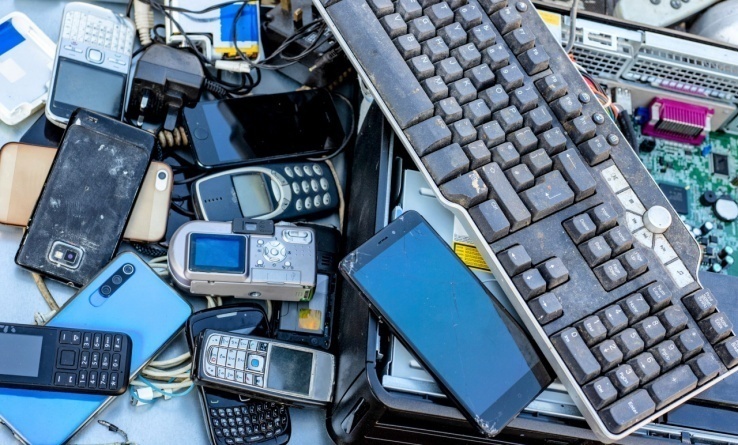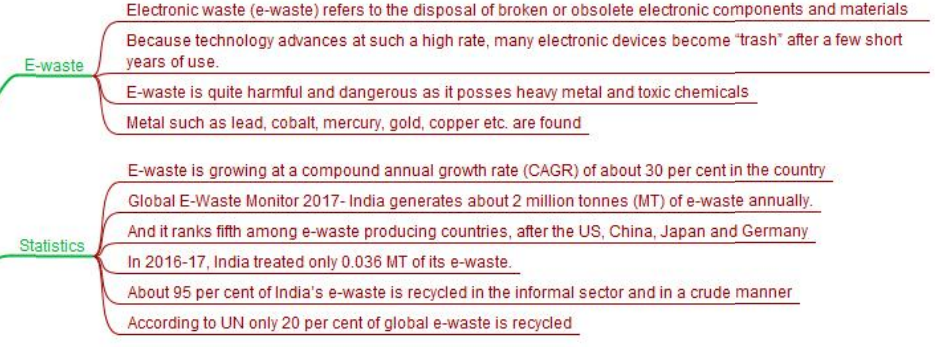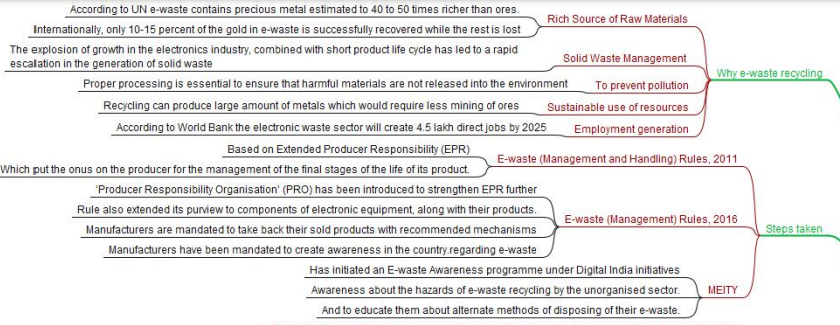Description

Disclaimer: Copyright infringement not intended.
Context
- Consumer goods companies and makers of electronics goods have to ensure at least 60% of their electronic waste is collected and recycled by 2023 with targets to increase them to 70% and 80% in 2024 and 2025, respectively
Background of e- Waste
- According to Global E-waste Monitor 2020, Global e-waste will increase by 38 per cent in the decade between 2020 and 2030.
- There was 6 million tonnes of electronic waste in 2019 which is an average of 7.3 kg per capita. That is a nearly 21 per cent increase in just five years
- Asia generated the greatest volume of e-wastein 2019.
- Most E-waste in 2019 consisted of small equipment, large equipment and temperature exchange equipment.
- Less than 18 per cent of the e-waste generated in 2019 was collected and recycled.
- The number of countries that have adopted a national e-waste policy, legislation or regulation has increased from 61 to 78 and includes India. It is far from the target set by the International Telecommunication Union to raise the percentage of countries with an e-waste legislation to 50 per cent.
- The Global E-waste Monitor 2020 is a collaborative product of the Global E-waste Statistics Partnership, formed by the United Nations University, International Telecommunication Union, International Solid Waste Association, UN Environment Programme.
E-Waste
- E-Waste is short for Electronic-Waste and the term used to describe old, end-of-life or discarded electronic appliances.
- It is categorised into 21 types under two broad categories: Information technology and communication equipment and Consumer electrical and electronics.
- E-waste includes their components, consumables, parts and spares.
- E-waste contains several toxic additives or hazardous substances such as mercury, brominated flame retardants (BFR), CFCs and HCFCs.
- The increasing levels of e-waste, low collection rates, and non-environmentally sound disposal and treatment of this waste stream pose significant risks to the environment and to human health.
- International E-Waste Day has been observed on 14th Octobersince 2018.
India specific
- There are 312 authorised recyclers of e-waste in India, with the capacity for treating approximately 800 kilotonnes annually.
- About 90 per cent of the country’s e-waste is recycled in the informal sector.
- India’s first e-waste clinic for segregating, processing and disposal of waste from household and commercial units has been set-up in Bhopal, Madhya Pradesh.
- According to the Central Pollution Control Board (CPCB), India generated more than 10 lakh tonnes of e-waste in 2019-20, an increase from 7 lakh tonnes in 2017-18. Against this, the e-waste dismantling capacity has not been increased from 7.82 lakh tonnes since 2017-18.
Concerns:
- Toxicity:E-waste consists of toxic elements such as Lead, Mercury, Cadmium, Chromium, Polybrominated biphenyls and Polybrominated diphenyl.
- Effects on Humans:Some of the major health effects include serious illnesses such as lung cancer, respiratory problems, bronchitis, brain damages, etc. due to inhalation of toxic fumes, exposure to heavy metals and alike.
- Effects on Environment:E-waste is an environmental hazard causing groundwater pollution, acidification of soil and contamination of groundwater and air pollution due to the burning of plastic and other remnants.
Challenges Related to Management of E-Waste in India:
- A key factor in used electronic devices not being given for recycling was because consumers themselves did not do so.
- In India, about 5 lakh child laborers in the age group of 10-14 are observed to be engaged in various E-waste activitiesand that too without adequate protection and safeguards in various yards and recycling workshops.
- There is absence of any public information on most State Pollution Control Boards (SPCBs)/PCC websites.
- No clear guidelines are there for the unorganized sectorto handle E-waste.
- Also, no incentives are mentioned to lure people engaged to adopt a formal path for handling E-waste.
- 80% of E-waste in developed countries meant for recycling is sent to developing countries such as India, China, Ghana and Nigeria.
- Lack of coordination between various authoritiesresponsible for E-waste management and disposal including the non-involvement of municipalities.
- End of life computers often contain sensitive personal information and bank account details which, if not deleted leave opportunity for fraud.
International Conventions and government initiatives:
- Originally the Basel Conventiondid not mention e-waste but later it addressed the issues of e-waste in 2006 (COP8).
- Nairobi Declarationwas adopted at COP9 of the Basel Convention. It aimed at creating innovative solutions for the environmentally sound management of electronic wastes.
- Rotterdam Convention, 2004seeks to promote exchange of information among Parties over a range of potentially hazardous that may be exported or imported.
- In India prior to 2011, e-waste was covered under the Hazardous Waste Management (HWM) Rules.
- In 2011, under the Environmental Protection Act 1986, the E-waste (Management and Handling) Rules, 2011 were enacted
- In 2016, the E-Waste (Management) Rules, 2016were enacted which replaced the 2011 Rules. The Rules were amended in 2018
- CPCB has also issued guidelines Environmentally Sound Management of E-waste (on Collection, Storage, Dismantling & Segregation, Recycling, and Treatment & Disposal of E-Waste)
- Awareness Program on Environmental Hazards of Electronic Wasteinitiated by Ministry of Electronics and Information Technology
- Creation of Management Structure for Hazardous Substancesseeks to raise awareness among people about the 2016 Rules and its implementation.
- Swachh Digital Bharatseeks to create awareness among the public about the hazards of e-waste recycling by the unorganised sector, and to educate them about alternate methods of disposing of their e-waste.
NGT’s Directions
- Further steps should be taken for scientific enforcement of E-Waste Management Rules, 2016 (EWMR) in the light of the reports of the CPCB.
- It noted gaps in collection targets, as the amount of e-waste collected in 2018-19 was 78,000 tonnes against a target of 1.54 lakh tonnes. There are clear governance deficits on the subject.
- The CPCB may consider steps for compliance of Rule 16 requiring reduction in the use of Hazardous substances in the manufacture of electrical and electronic equipment and their components or consumables or parts or spares.
- It took note that a large number of accidents take place in residential areas on account of unscientific handling of e-waste.
- This needs special attention for constant vigilance in such hotspots. This also requires review and updation of siting norms for e-waste by the CPCB which may be done within three months.
- All the state pollution control boards need to identify the hotspots by constant vigil and to coordinate with the District Administrationat local levels to prevent damage to the environment and public health and meaningful enforcement of rule of law.
E-Waste Management Rules, 2016
- The Ministry of Environment, Forest and Climate Change notifiedthe E-Waste Management Rules, 2016 in supersession of the E-waste (Management & Handling) Rules, 2011.
- Over 21 products (Schedule-I) were included under the purview of the rule. It included Compact Fluorescent Lamp (CFL) and other mercury containing lamps, as well as other such equipment.
- For the first time, the rules brought the producers under Extended Producer Responsibility (EPR), along with targets. Producers have been made responsible for the collection of E-waste and for its exchange.
- Various producers can have a separate Producer Responsibility Organisation (PRO) and ensure collection of E-waste,as well as its disposal in an environmentally sound manner.
- Deposit Refund Schemehas been introduced as an additional economic instrument.
- The role of State Governments has been also introducedto ensure safety, health and skill development of the workers involved in dismantling and recycling operations.
- A provision of penalty for violation of rules has also been introduced.
- Urban Local Bodies (Municipal Committee/Council/Corporation) have been assigned the duty to collect and channelize the orphan productsto authorized dismantlers or recyclers.
- Allocation of proper space to existing and upcoming industrial units for e-waste dismantling and recycling.
|
Best Practices
‘Take-back’ and ‘Planet ke Rakwale’ campaign- Nokia: Nokia set up drop boxes across the country to take back used phones, chargers and accessories, irrespective of the brand, at Nokia Care Centres. Nokia launched “Planet Ke Rakhwale” take-back and recycling campaign which extended to 28 cities across India.
“Green Warriors” in Telangana have been a part of the recycling / refurbishing chain, and has contributed towards the successful implementation of measures to control e-pollution. Their efforts have also been recognized by the Telangana government in its Telangana e-waste
|
Way Forward
- There is need for better implementation methodologies and inclusion policiesthat provide accommodation and validation for the informal sector to step up and help us meet our recycling targets in an environmentally sound manner.
- Also, successfully raising collection ratesrequired every actor to be involved, including consumers.
- There is a need to strengthen the domestic legal frameworkto address the issue of unregulated imports of e-waste
- Steps should be taken to formalize the informal sectorby integrating it with the formal sector.
- Government should introduce vocational training programsto rightly skill the current unorganized sector employees to ensure their smoother transition to working with organized sector
- Governments must encourage research into the development of better environmentally-sustainable e-waste recycling techniques
- There is urgent need for a detailed assessment of the E-wasteincluding quantification, characteristics, existing disposal practices, environmental impacts.
- There is need of an effective take-back program providing incentives to producers.
- Mass awareness programmesshould be initiated to encourage consumers to reuse/ recycle electronic products.
In a nutshell, (-IASGYAN MIND MAP)




https://epaper.thehindu.com/Home/ShareArticle?OrgId=G4P9RMG92.1&imageview=0
1.png)















